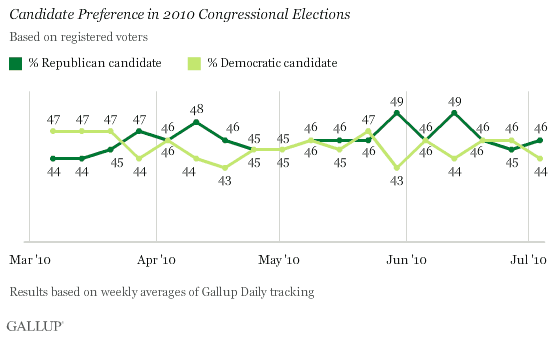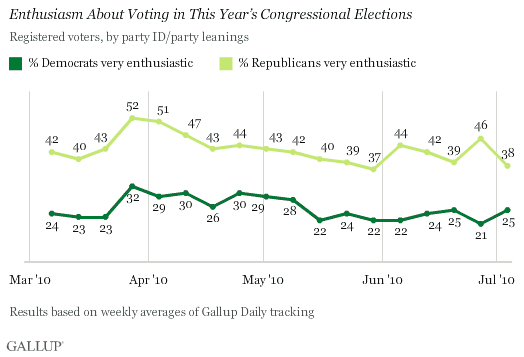PRINCETON, NJ -- Republicans maintain their competitive position on the generic congressional ballot, with 46% of U.S. registered voters preferring the Republican candidate in their district and 44% the Democratic candidate. The Republicans have statistically tied or led the Democrats on this measure in every Gallup weekly average since mid-March.

The latest results are based on Gallup Daily tracking for the week ending July 4, with no interviewing on the Independence Day holiday. Gallup historical trends suggest that a slight Republican lead on the generic ballot among registered voters -- or even a statistical tie -- would translate into sizable Republican seat gains in Congress on Election Day, given their typical advantage in voter turnout.
Republicans' Enthusiasm Lead Persists
Overall enthusiasm for voting in the 2010 midterm elections held steady in the latest weekly average, with 30% of registered voters saying they are very enthusiastic, although this is down from the higher enthusiasm levels of late March and April. Republicans continue to hold a significant edge on this potentially important indicator of voter turnout rates. The current 13 percentage-point GOP enthusiasm lead is similar to the average 17-point lead the party has held since March.

Monthly Preferences Highly Stable
Voter preferences for Congress have been highly stable on a monthly basis since Gallup began Daily tracking of the generic ballot in March. The gap between Democrats and Republicans has been either one or two points each month, including June, when an average of 47% preferred the Republican candidate in their district and 45% preferred the Democrat.
Each month that Republican parity with the Democrats is maintained reduces the likelihood that the Democrats will move into a substantial lead before November. Prior Gallup analysis has found that the party preferences for Congress seen in the first quarter of a midterm election year generally carry through to Election Day. The only recent example of a major change as late as the summer or fall came in 2002, when Democratic support surged in July and August, but diminished by Election Day; indeed, that year, the Republicans retained their majority status in Congress.
Editor's note: The original version of this story inadvertently referred to national adults rather than registered voters in the survey methods statement. The results reported here and in all Gallup generic ballot trends so far this year are based on registered voters; the survey methods statement now correctly reflects that.
Results are based on telephone interviews conducted as part of Gallup Daily tracking June 28-July 3, 2010, with a random sample of 1,354 registered voters, aged 18 and older, living in all 50 U.S. states and the District of Columbia, selected using random-digit-dial sampling.
For results based on registered voters, one can say with 95% confidence that the maximum margin of sampling error is ±3 percentage points.
Interviews are conducted with respondents on landline telephones and cellular phones, with interviews conducted in Spanish for respondents who are primarily Spanish-speaking. Each daily sample includes a minimum quota of 150 cell phone respondents and 850 landline respondents, with additional minimum quotas among landline respondents for gender within region. Landline respondents are chosen at random within each household on the basis of which member had the most recent birthday.
Samples are weighted by gender, age, race, Hispanic ethnicity, education, region, adults in the household, cell phone-only status, cell phone-mostly status, and phone lines. Demographic weighting targets are based on the March 2009 Current Population Survey figures for the aged 18 and older non-institutionalized population living in U.S. telephone households. All reported margins of sampling error include the computed design effects for weighting and sample design.
In addition to sampling error, question wording and practical difficulties in conducting surveys can introduce error or bias into the findings of public opinion polls.
For more details on Gallup's polling methodology, visit https://www.gallup.com/.
